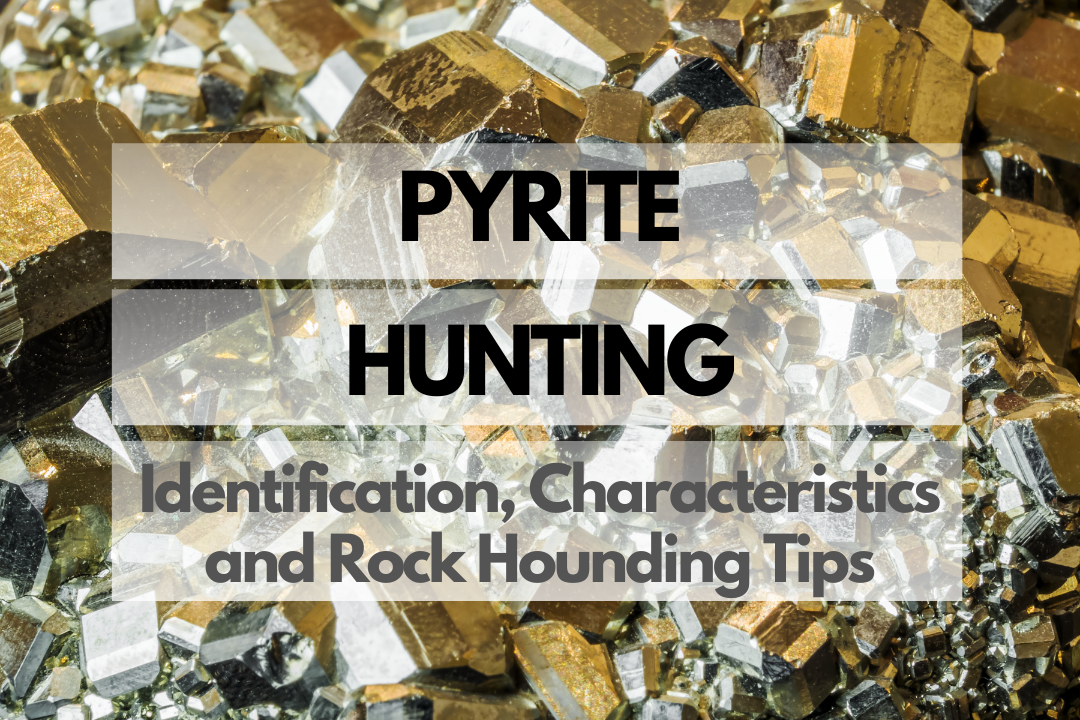Are you captivated by the unmistakable gleam of pyrite, also known as “Fool’s Gold”? This fascinating mineral has a long history, unique characteristics, and a variety of uses that make it an exciting target for rock hounds. In this article, we’ll explore the world of pyrite, providing you with all the information you need to track down and identify this alluring mineral. Let the adventure begin!
History & Origin of Pyrite
Pyrite has been known since ancient times due to its metallic luster and resemblance to gold. The name “pyrite” comes from the Greek word “pyr,” meaning “fire,” as the mineral can produce sparks when struck against metal or another hard surface. In various cultures, pyrite has been used for both practical and ornamental purposes. For example, Native Americans utilized pyrite as a fire starter, while the ancient Greeks and Romans used it in jewelry and decorative objects.
Pyrite Identification & Physical Properties
Pyrite can be easily recognized by its unique characteristics. The following table provides an overview of its physical properties:
| Property | Description |
|---|---|
| Chemical Formula | FeS2 (Iron sulfide) |
| Crystal System | Isometric |
| Luster | Metallic |
| Streak | Greenish-black to brownish-black |
| Transparency | Opaque |
| Cleavage | None, conchoidal fracture |
| Specific Gravity | 4.9 – 5.2 |
Pyrite Colors
Pyrite is typically brass-yellow in color, which contributes to its nickname, “Fool’s Gold.” However, the mineral can also exhibit shades of pale yellow, silver, or even gray, depending on the impurities present.
Pyrite Hardness
Pyrite has a Mohs hardness of 6 to 6.5, making it a relatively hard mineral. This characteristic, combined with its distinct metallic luster, helps to distinguish pyrite from actual gold, which is softer with a hardness of 2.5 to 3.
Pyrite Types
Pyrite can be found in several different forms due to variations in its crystal structure. Some of the most common types of pyrite include:
Cubic Pyrite
Cubic pyrite is the most common form of pyrite, characterized by its well-formed, cube-shaped crystals. These crystals can vary in size from tiny to several centimeters across, and are often found in sedimentary and metamorphic rocks.
Pyritohedron Pyrite
Pyritohedron pyrite features crystals with a dodecahedron shape, composed of twelve pentagonal faces. This type of pyrite is less common than cubic pyrite and is typically found in hydrothermal veins and igneous rocks.
Radiated Pyrite
Radiated pyrite is characterized by its unique, radiating crystal clusters that resemble a sunburst or sea urchin. This form of pyrite often occurs in association with other minerals, such as quartz and calcite.
Pyrite Uses
Pyrite has a variety of uses, both practical and decorative. Some of the most common uses include:
- Jewelry and ornamentation: Due to its attractive appearance, pyrite is often used in jewelry and other decorative objects.
- Fire starter: Pyrite can be used to produce sparks, making it a useful tool for starting fires in primitive settings.
- Sulfuric acid production: Pyrite is a major source of sulfur, which can be extracted and used in the production of sulfuric acida key component in various industrial processes.
- Collector’s item: Pyrite is a popular mineral among rock hounds andmineral collectors, who appreciate its unique crystal forms and metallic luster.
How Much Is Pyrite Worth?
Pyrite’s value is relatively low compared to other precious minerals and gemstones. The price of pyrite specimens depends on factors such as size, crystal formation, and overall aesthetics. Small, common specimens can be found for just a few dollars, while larger, more impressive specimens with well-formed crystals can range from $10 to several hundred dollars. However, keep in mind that the value of pyrite is largely subjective and can vary based on individual tastes and preferences.
Pyrite Rock Hounding Tips
Ready to embark on a thrilling pyrite hunting adventure? Here are some tips and tricks to help you have a successful and enjoyable experience.
Essential Tools and Equipment
Having the right tools and equipment is crucial for a successful pyrite hunting expedition. Some essentials to consider include:
- Rock hammer: A rock hammer is indispensable for breaking open rocks and extracting pyrite specimens.
- Chisel: A chisel can help you carefully remove pyrite crystals from their matrix without damaging them.
- Hand lens or magnifier: A hand lens or magnifying glass will help you identify pyrite and inspect its crystal structure more closely.
- Safety goggles: Protect your eyes from flying rock fragments when using a hammer or chisel.
- Sturdy gloves: Gloves will protect your hands from sharp rocks and other hazards during your hunt.
- Backpack or rock collecting bag: Carry your tools and specimens in a durable backpack or rock collecting bag.
- Field guide: A comprehensive field guide will help you identify pyrite and other minerals you may encounter.
Safety Tips
When rock hounding for pyrite, always prioritize your safety. Here are some safety tips to keep in mind:
- Wear appropriate clothing, including long pants, closed-toe shoes, and a hat to protect yourself from the sun.
- Stay hydrated and bring ample water, especially when hunting in hot or remote areas.
- Never go rock hounding alone; bring a buddy or join a group for added safety.
- Be aware of your surroundings and watch for potential hazards, such as loose rocks, steep cliffs, and wildlife.
- Carry a first aid kit and know how to use it in case of an emergency.
- Respect private property and always ask for permission before entering or collecting specimens.
Pyrite Hunting: Where to Find Pyrite
Pyrite can be found in various geological environments worldwide, including in hydrothermal veins, igneous rocks, sedimentary rocks, and metamorphic rocks. Some of the best places to find pyrite include:
| Site/Area | City/State/Country |
|---|---|
| Navajún Mine | La Rioja, Spain |
| Elba Island | Tuscany, Italy |
| Huanzala Mine | Anchash, Peru |
| Mollie Kathleen Gold Mine | Cripple Creek, Colorado, USA |
| Iron Pyrite Belt | Andalusia, Spain |
| Bisbee | Arizona, USA |
Caring For Your Pyrite
To maintain the appearance and integrity of your pyrite specimens, follow these care tips:
- Avoid exposing pyrite to water or high humidity, as it can cause the mineral to degrade over time.
- Keep pyrite away from direct sunlight, as prolonged exposure can cause the mineral to fade.
- Store your pyrite specimens in a cool, dry place to minimize the risk of tarnishing or oxidation.
- Handle pyrite with care to avoid damaging its delicate crystal structure.
Additional Resources
For further information and resources on pyrite, consider the following:
- United States Geological Survey (USGS) – www.usgs.gov
- Mindat.org – www.mindat.org
- Rock and Gem Magazine – www.rockngem.com
- The Mineralogical Society of America – www.minsocam.org
- Books: “Rocks, Minerals, and Gemstones: An Introductory Study Guide” by Rupert Hochleitner and “Rock and Gem: The Definitive Guide to Rocks, Minerals, Gemstones, and Fossils” by Ronald L. Bonewitz
Additional Pyrite FAQs
What are the benefits of Pyrite?
Although pyrite has limited practical uses, it is highly valued by mineral collectors for its striking appearance and well-developed crystal forms. Pyrite is also known as “fool’s gold” due to its gold-like luster, making it a popular mineral among those with an interest in gold prospecting and history.
Do Pyrite have any healing properties?
While some people believe that pyrite has healing properties, there is no scientific evidence to support these claims. Pyrite is often associated with promoting positive energy, grounding, and shielding from negative influences, but these ideas are based on metaphysical beliefs rather than empirical data.
Do Pyrite have any spiritual meaning?
In various spiritual and metaphysical traditions, pyrite is associated with attracting abundance, enhancing willpower, and fostering a sense of confidence and determination. However, these associations are based on personal beliefs and experiences rather than any universally accepted spiritual or religious doctrine.
Do I need a permit to go Pyrite hunting?
Permit requirements for rock hounding vary depending on the location and land ownership. In the United States, permits may be required for collecting on certain public lands, such as national forests or Bureau of Land Management areas. To determine if a permit is needed, consult the relevant land management agency’s website or contact their local office. Some examples include:
- US Forest Service – www.fs.usda.gov
- Bureau of Land Management – www.blm.gov
Closing Thoughts
With the right knowledge, tools, and safety precautions, pyrite rock hounding can be an exciting and rewarding hobby. As you venture out to discover the fascinating world of pyrite and other minerals, remember to respect the environment, follow local regulations, and enjoy the thrill of the hunt. Happy rock hounding!

